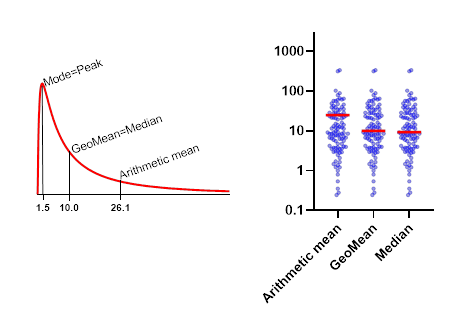There are several ways for calculating confidence intervals for the mean of a lognormal distribution. I am going to present two methods: Bootstrap and Profile likelihood. I will also present a discussion on the Jeffreys prior.
Bootstrap
For the MLE
In this case, the MLE of $(\mu,\sigma)$ for a sample $(x_1,...,x_n)$ are
$$\hat\mu= \dfrac{1}{n}\sum_{j=1}^n\log(x_j);\,\,\,\hat\sigma^2=\dfrac{1}{n}\sum_{j=1}^n(\log(x_j)-\hat\mu)^2.$$
Then, the MLE of the mean is $\hat\delta=\exp(\hat\mu+\hat\sigma^2/2)$. By resampling we can obtain a bootstrap sample of $\hat\delta$ and, using this, we can calculate several bootstrap confidence intervals. The following R codes shows how to obtain these.
rm(list=ls())
library(boot)
set.seed(1)
# Simulated data
data0 = exp(rnorm(100))
# Statistic (MLE)
mle = function(dat){
m = mean(log(dat))
s = mean((log(dat)-m)^2)
return(exp(m+s/2))
}
# Bootstrap
boots.out = boot(data=data0, statistic=function(d, ind){mle(d[ind])}, R = 10000)
plot(density(boots.out$t))
# 4 types of Bootstrap confidence intervals
boot.ci(boots.out, conf = 0.95, type = "all")
For the sample mean
Now, considering the estimator $\tilde{\delta}=\bar{x}$ instead of the MLE. Other type of estimators might be considered as well.
rm(list=ls())
library(boot)
set.seed(1)
# Simulated data
data0 = exp(rnorm(100))
# Statistic (MLE)
samp.mean = function(dat) return(mean(dat))
# Bootstrap
boots.out = boot(data=data0, statistic=function(d, ind){samp.mean(d[ind])}, R = 10000)
plot(density(boots.out$t))
# 4 types of Bootstrap confidence intervals
boot.ci(boots.out, conf = 0.95, type = "all")
Profile likelihood
For the definition of likelihood and profile likelihood functions, see. Using the invariance property of the likelihood we can reparameterise as follows $(\mu,\sigma)\rightarrow(\delta,\sigma)$, where $\delta=\exp(\mu+\sigma^2/2)$ and then calculate numerically the profile likelihood of $\delta$.
$$R_p(\delta)=\dfrac{\sup_{\sigma}{\mathcal L}(\delta,\sigma)}{\sup_{\delta,\sigma}{\mathcal L}(\delta,\sigma)}.$$
This function takes values in $(0,1]$; an interval of level $0.147$ has an approximate confidence of $95\%$. We are going to use this property for constructing a confidence interval for $\delta$. The following R codes shows how to obtain this interval.
set.seed(1)
# Simulated data
data0 = exp(rnorm(100))
# Log likelihood
ll = function(mu,sigma) return( sum(log(dlnorm(data0,mu,sigma))))
# Profile likelihood
Rp = function(delta){
temp = function(sigma) return( sum(log(dlnorm(data0,log(delta)-0.5*sigma^2,sigma)) ))
max=exp(optimize(temp,c(0.25,1.5),maximum=TRUE)$objective -ll(mean(log(data0)),sqrt(mean((log(data0)-mean(log(data0)))^2))))
return(max)
}
vec = seq(1.2,2.5,0.001)
rvec = lapply(vec,Rp)
plot(vec,rvec,type="l")
# Profile confidence intervals
tr = function(delta) return(Rp(delta)-0.147)
c(uniroot(tr,c(1.2,1.6))$root,uniroot(tr,c(2,2.3))$root)
$\star$ Bayesian
In this section, an alternative algorithm, based on Metropolis-Hastings sampling and the use of the Jeffreys prior, for calculating a credibility interval for $\delta$ is presented.
Recall that the Jeffreys prior for $(\mu,\sigma)$ in a lognormal model is
$$\pi(\mu,\sigma)\propto \sigma^{-2},$$
and that this prior is invariant under reparameterisations. This prior is improper, but the posterior of the parameters is proper if the sample size $n\geq 2$. The following R code shows how to obtain a 95% credibility interval using this Bayesian model.
library(mcmc)
set.seed(1)
# Simulated data
data0 = exp(rnorm(100))
# Log posterior
lp = function(par){
if(par[2]>0) return( sum(log(dlnorm(data0,par[1],par[2]))) - 2*log(par[2]))
else return(-Inf)
}
# Metropolis-Hastings
NMH = 260000
out = metrop(lp, scale = 0.175, initial = c(0.1,0.8), nbatch = NMH)
#Acceptance rate
out$acc
deltap = exp( out$batch[,1][seq(10000,NMH,25)] + 0.5*(out$batch[,2][seq(10000,NMH,25)])^2 )
plot(density(deltap))
# 95% credibility interval
c(quantile(deltap,0.025),quantile(deltap,0.975))
Note that they are very similar.

